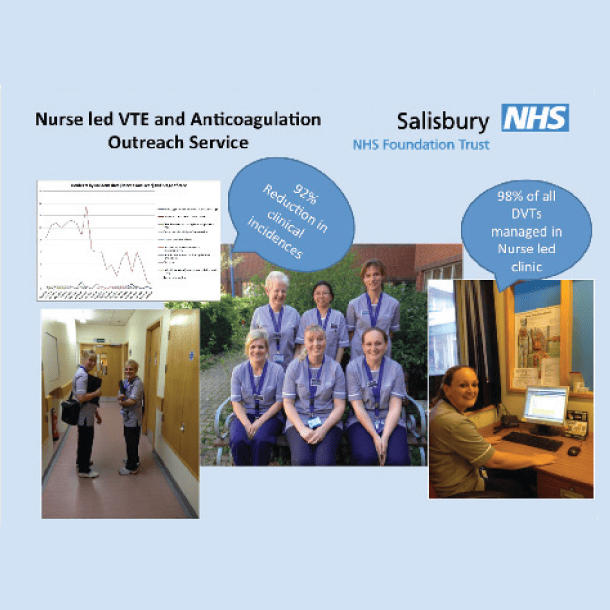Summary
These two services cover all aspects of a patient’s anticoagulation journey. The VTE service sees patients assessed in a nurse-led clinic, after which treatment is initiated or care escalated to medics if required. Its single-centre approach has delivered several key healthcare improvements. These include a significant reduction in hospital admissions for DVT and the efficient and safe introduction of novel oral anticoagulants (NOACs) into VTE pathways. The outreach anticoagulation service operates Monday to Friday on wards to assess all patients receiving anticoagulation. Patients on VKA are assessed and dosed and their bridging managed. NOAC patients are assessed and then counselling is provided. PE patients are seen and early discharge facilitated. For all groups, on-going care is organised and there has been a clear reduction in anticoagulation medication incidences since the implementation in September 2014.
Challenge
Historically patients with VTE (DVT & PE) were all managed via standard emergency approaches including medical admission. While this was regarded as being a 'safe' approach there were a number of disadvantages – not least that the majority of patients were seen as medical emergencies will be admitted to hospital and the opportunities for an integrated single-stop specialist care pathway may be more limited if VTE patients are managed in a mixed emergency environment. Patients were unhappy with the current process due to the amount of time it was taking to be seen and discharged home. Meanwhile, patients were being dosed by the anticoagulation nurses remotely, their INRs were sent to the lab for processing and then the anticoagulation dosing card completed. Ward doctors and nurses were asked to complete the chart with concomitant medication and any changes: this was time consuming for the anticoagulation nurses it was also frustrating for the ward nurses to be interrupted from patient care – and invariably the information was not completely accurate, making dosing potentially unsafe. Clinical incidences in anticoagulation were continually being flagged as a concern and general education of staff was clearly not having the desired impact.
Objectives
For the two services:
- To create an integrated pathway for VTE patients in an ambulatory setting which would reduce hospital admissions, increase patient and healthcare professional satisfaction with the service and streamline VTE management.
- To have an anticoagulation nurse specialist attending all inpatient wards on a weekday daily basis, improving patient care and satisfaction, reducing clinical incidences, assessing stable PE patients to facilitate a rapid discharge and providing counselling.
Solution
In February 2012 the acute nurse-led VTE service was launched. All patients come direct from scan to the nearby Pathology Outpatients Department to go through the following steps:
- Basic blood tests
- Standardised nurse assessment
- Involvement of consultants as needed
- Haematology for abnormal blood tests, issues related to anticoagulation
- Obstetric for pregnant women
- Acute medicine for unwell patients, those unsuitable for ambulatory care and complex co-morbidities
- Interventional radiology for patients who might be eligible for catheter-directed thrombolysis
- Initiation under patient group directive (PGD) and counselling for anticoagulant treatment
- Consideration and involvement in clinical trials if appropriate
- Letter to GP advising on further follow-up necessary including recommendations for cancer assessment / thrombophilia review.
A new tariff was generated and patients are now only sent to the medical assessment unit if further medical attention is required. It was agreed that by increasing the current staffing levels, anticoagulation nursing could be expanded to offer a ward service. The nurse attended each ward and monitored the INR using a point of care machine, the INR was then used to dose the patient, ensuring that the current medication and general condition of the patient was taken into consideration. It was also an ideal opportunity for the patient to ask questions and was provided with their dosing information. The service now covers all inpatient wards.
Results
Management of the first cohort of 499 VTE clinic patients from February 2012 to June 2013 was with warfarin: 98% were treated and discharged, with only 2% requiring hospital admission. None of the patients discharged subsequently required admission in the following week. In the second cohort of 643 patients from July 2013 to November 2014, first line management for first VTE was with Rivaroxaban (44%) in eligible patients (low-molecular-weight-heparin in cancer patients or SELECT-D trial) and warfarin (56%). This single-centre approach has delivered several key healthcare improvements, including a significant reduction in hospital admissions for DVT, recognition of patients who need specialist input with consultant level intervention brought to the patient, clear communication with primary care over ongoing roles and responsibilities in management, and efficient and safe introduction of NOACs into VTE pathways. There has also been a reduction in anticoagulation medication incidences, down from between 20-30 per month to 3-15 per month. The average of 9 per month is a significant improvement on previous periods.
Learnings
It is really important to do the ground work and understand the needs of the service. One area of difficulty was that other departments were not particularly willing to accommodate any change. However, the vascular department did alter the last DVT scan of the day to fit in with the pathology opening times. This ensured that the department was still open for the patient to have their bloods taken prior to commencing treatment.Evaluation
We have recently sent out a patient satisfaction survey to randomly selected patients, 50 who were provided with warfarin and 50 with Rivaroxaban. We have received 53% of these replies and the majority are positive.



